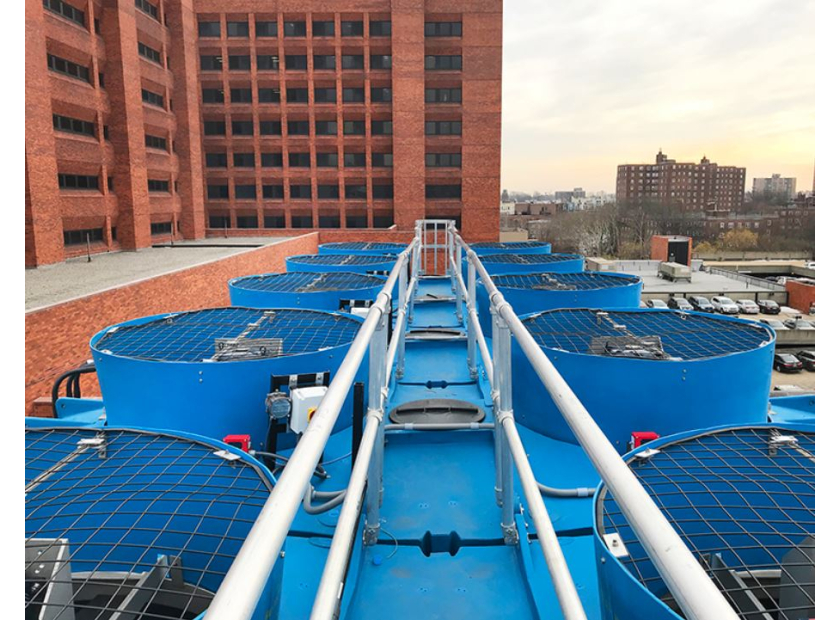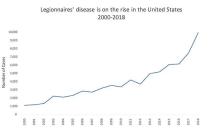Cooling Towers That Spread Legionella Infections
Rising Legionella Infections and Its Prevention in Industrial Cooling Towers
Although Legionella is found naturally in freshwater environments, it becomes a health concern to the population when it becomes established in building water systems including showerheads, sink faucets, hot tubs, decorative fountains, hot water tanks, heaters, and cooling towers.(1)
An industrial cooling tower is a critical component of many refrigeration systems and can be found in industries such as power plants, chemical processing, steel mills, and many manufacturing companies where process cooling is necessary. Also, a commercial cooling tower can be used to provide comfort-cooling for large commercial buildings like airports, schools, hospitals (shown in the photo above), or hotels.
If not properly sanitized and monitored, these systems, having substantial amounts of water, can be an ideal habitat for Legionella, a heat-loving organism.(2) Cooling towers take warm water generated during an industrial process, and spray it through nozzles to maximize its contact with cool outside air.(3,4)

This process creates a heat exchange, where some water evaporates and dissipates from the top of the tower. Aerosolized water can then spread over miles and carry Legionella along the way, if present.(4)
Individuals inhaling aerosolized water contaminated with Legionella can develop legionellosis, a disease consisting of three distinct clinical and epidemiological illnesses: Legionnaires’ disease, Pontiac fever, and extrapulmonary legionellosis. Legionnaires’ disease is a serious type of pneumonia. Pontiac fever is a milder infection that rarely requires antibiotic treatment. Extrapulmonary legionellosis is associated with endocarditis and wound, joint, and graft infections.(5)
Legionnaires’ disease is a common cause of community-acquired pneumonia that usually requires hospitalization.
According to the CDC, Legionnaires’ disease cases have been on the rise since 2000 with close to 10,000 reports in the United States in 2018 (see the graph below).(6) Graham et al. conducted a systematic review and meta-analysis to determine the mean percentage where Legionella is the causative agent for community-acquired pneumonia and its incidence rate.

This investigation reviewed 2,778 global studies and included 219 in the meta analysis.
The mean proportion of Legionella as the causative agent for community-acquired pneumonia was 4.6% (95% CI: 4.4 - 4.7) and the mean incidence rate was 2.8 per 100,000 population (95% CI: 2.7 - 2.9).(7)
Almost 5% of all pneumonias are caused by Legionella
Therefore, controlling Legionella in cooling towers is of considerable importance to prevent outbreaks. The design, operation, maintenance, control limits, and remediation protocols should be taken into consideration to ensure public safety.
Locating these cooling towers at least 25 feet from building air intake ducts can prevent aerosolized water from being drawn into a ventilation system.
Also, understanding cooling tower design components, using high-efficiency drift eliminators to capture large water droplets in the cooling tower air stream, avoiding water stagnation in the system, recirculating water during intermittent operation, and designing and installing an automated water treatment system can avert bacterial growth.
Lastly, when an outbreak or illness is confirmed, taking the necessary cleaning, disinfecting, and remediation steps while working with the corresponding public health authority can prevent the increase in legionellosis cases.(8)
Hardy offers a complete line of culture media designed to detect Legionella for the purpose of monitoring potentially dangerous cooling towers.
Meet the author

TECHNICAL SERVICES MICROBIOLOGIST II at HARDY DIAGNOSTICS
Elide Herrera
Elide graduated from Cal Poly, San Luis Obispo with a B.S. in Biochemistry. She has been part of the Technical Services department at Hardy Diagnostics since 2021. Elide is dedicated to helping bring medical devices to market by taking them through the 510(k) process for FDA clearance. She also takes great pride in assisting customers with their technical support needs. In her free time, she loves spending time with her family, dancing to Latin music, and exploring new hobbies.









